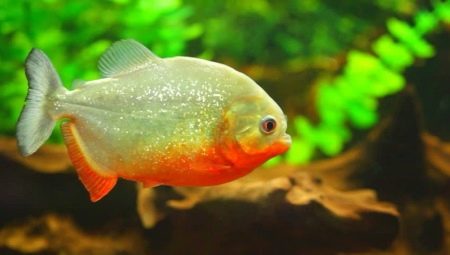Choosing a new pet for your aquarium, it is not necessary to buy boring familiar fish. You can choose something more original or dangerous. Piranhas have become quite popular thanks to various myths hanging around them. Many consider them bloodthirsty predators, but this is not quite the right judgment. Among piranhas, there are those who eat only algae. It is them who are usually bought by the owners of aquariums.

Description
In the natural environment, such fish grow up to 35 centimeters. Piranhas live in large bodies of water, for example, in rivers, lakes or in the flooded forests of the Amazon. Locals call them “devil-fish” because of the cruel nature of such creatures. If there are a lot of piranhas, and they hunt in a group, then they can tear their prey into pieces in a matter of minutes. However, this only happens if they feel the danger, there is a huge feeling of hunger, or they fall into the trap. In some countries, for example, in Israel, there is a ban on the trade or catch of this species of fish.
Aquarium piranhas do not grow longer than 25 centimeters. In artificially created conditions, they can live up to 15 years, and in some cases they can exist a little longer. Although piranhas are too hostile towards other fish, they are also fearful. They hide in the most hidden places, and only smelling food nearby, they will rush towards it with the speed of lightning. About 60% of piranhas eat only plant foods. As for their appearance, the piranhas are quite large in size. Their body is slightly flattened on their sides.
The jaw is slightly convex, and the teeth are huge and sharp. The tail of the piranhas is quite powerful, the color is predominantly gray-silver, and the belly is cast in red.
The character of aquarium piranhas is quite aggressive, so they often fight. However, despite this, their wounds heal very quickly, and in their place there is not even a trace left. For their neighbors, they are very dangerous, in addition, if the owner gaps a little during feeding, then the fish can even bite. But if they are kept in small groups of 3-4 individuals, then the piranhas will be shy. When a school consists of more than 10 fish, they feel more confident.
In addition, among them often dominant individuals appear who regale themselves with the best food.
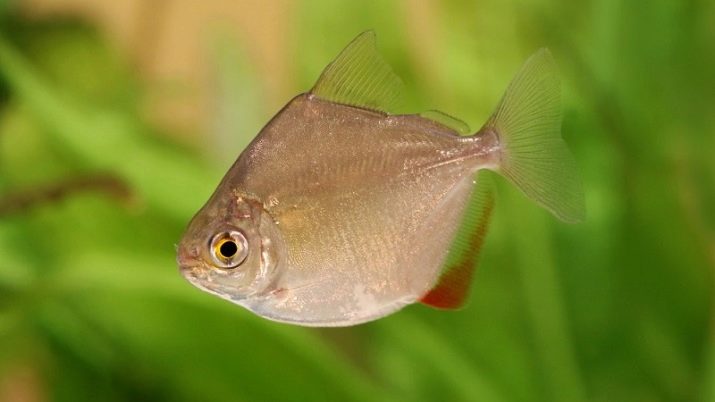
Varieties
Today, there are about 100 types of piranhas, among which brown or black pacu are considered the most popular.
Brown
Such piranha on average can grow up to 65 centimeters and have a weight of up to 40 kilograms. Her body is gray or brown in color, it is slightly flattened on the sides, and the eyes of the fish are huge. The teeth are a bit like human teeth. Piranha just bites through its victim. Fat makes up 10% of the total body weight of piranha. In an aquarium they are most often kept singly or in pairs. By nature, brown piranhas are considered herbivores, therefore prefer to eat plankton or insects.
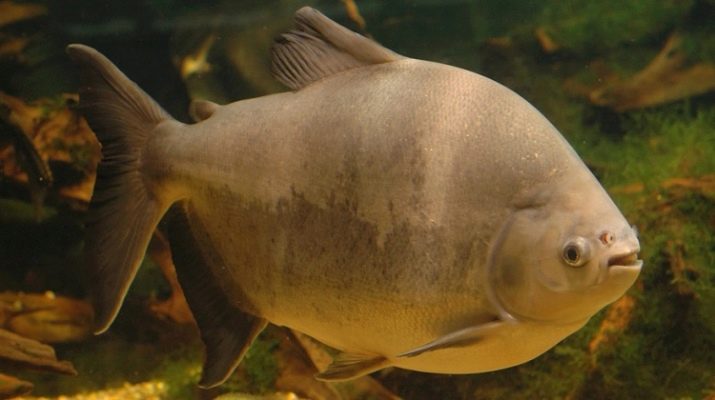
Red
Piranhas of this species are herbivores. In the aquarium, they can grow up to 55-60 centimeters. By its nature, it is a fairly peaceful fish, which allows it to be kept with other creatures, even smaller ones. There are several more names for this piranha, for example, red-bellied or red-breasted pacu. Her body is painted silver, and the lower abdomen, as well as the fins, have a red tint. A dark line runs along the very edge of the tail.
The red piranhas are omnivores, however, nuts are the main part of their diet. The volume of water in the aquarium should be at least 200 liters. Such fish live up to 25 years.
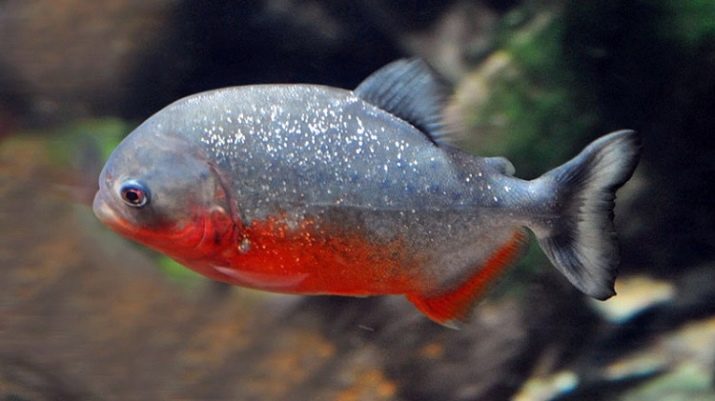
Flag
By their nature, these piranhas are predators. Therefore, it is best to keep them in a separate aquarium. After all, they will simply eat smaller fish, and in large ones they can gnaw both the fins and all the scales.
The length of their body in the aquarium can reach up to 14 centimeters, in shape it is flattened on both sides. The back has a green color, and the wings on the gills have a red spot, in addition, they have a bifurcated tail.
The flag jaws of the piranhas are quite massive, and in appearance they are quite dangerous.
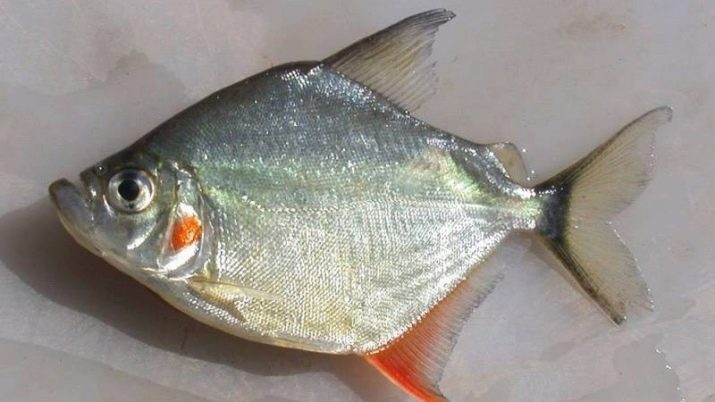
Slender
Piranha got this name because of its long physique. Their size reaches 35 centimeters. Their color is silver, on the tail there is a black border, the sides are red. The nature of piranhas is aggressive. When the fry grow to two centimeters, they begin to beat with each other, and the wounds can be large. It is best to keep them separate.

Natterera
These piranhas got their name in honor of a scientist from Austria. Their physique resembles a disk in shape and can grow up to 30 centimeters in length. The color of the piranhas is bright blue, and the fins and chest are red. The tail is almost black, with a blue stripe that runs vertically.
When the young piranha turns 7-8 months old, its color changes - it acquires a silver-gray color. The sides turn pink, and small golden sparkles follow them. Males are slightly smaller than females.
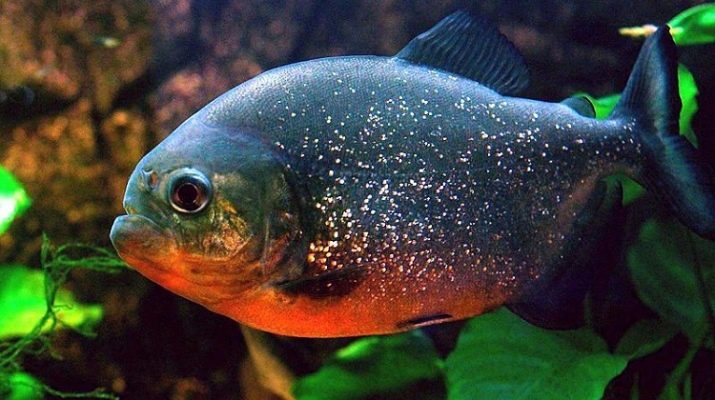
Metinnis lunar
All representatives of this species have a large physique and can grow up to 23 centimeters. Ripening occurs after 18 months. The body has a silver color. And the fins on the gills are reddish. Such piranhas feed on vegetation. They eat cabbage or salad with great pleasure.
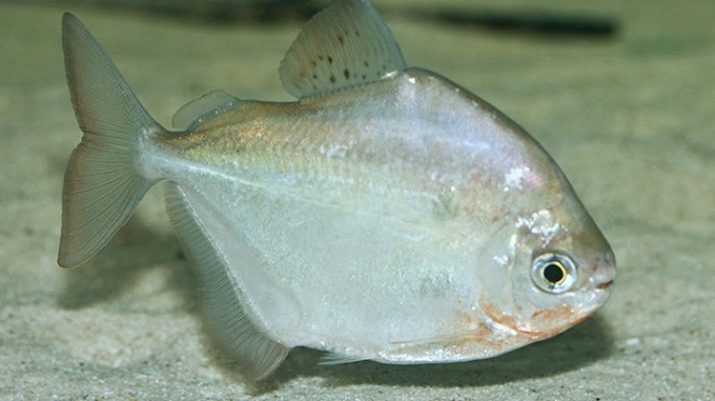
Silver Metinnis
The appearance of such piranhas is attractive. By themselves, they are small, up to 10 centimeters in length. Build These piranhas are flattened with a gray-silver tint, the tail is painted pink-red.There are small dots on the sides. Such fish feed mainly on plant foods. Can live up to 12 years.
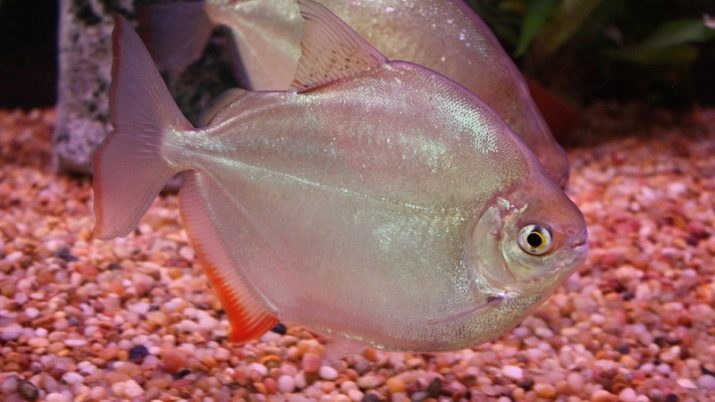
Common metinnis
Piranhas of this species have a peaceful character and are medium in size. They grow up to 14 centimeters. Their second name, which is also popular, is a fish-mirror. Their physique is rounded and slightly flattened. Their color is silver gray, with a green overflow.
Since such creatures are considered pack animals, you can keep them in aquariums in small groups.
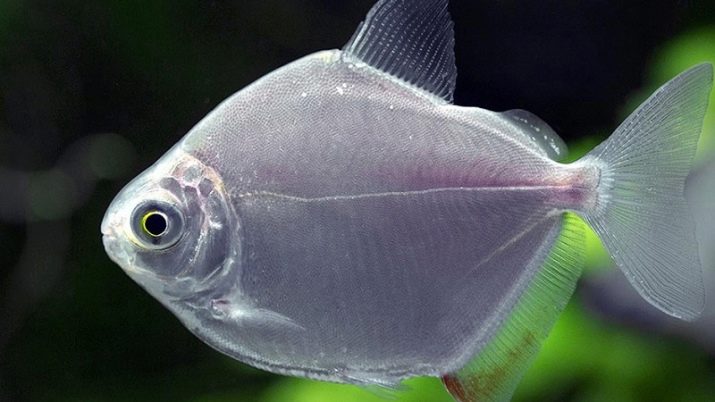
Compatibility
These fish can be kept in special species containers. Predatory piranhas can coexist with large catfish. A tiny little fish will simply become prey for them. But those who feed on vegetation can be kept with marine creatures similar in size to them, for example, it can be shark barbs.
Growing conditions
Keeping such marine inhabitants in the aquarium will require not only a lot of food, but also a large capacity, special equipment and proper care. For home maintenance on one piranha, you need an aquarium, the volume of which will be at least 125 liters. If this is a group that consists of 3-4 individuals, then the capacity should be at least 500 liters. To maintain a large flock of piranhas, an aquarium of several thousand liters is required.
Besides, you need to monitor the water that is poured into the tank. The temperature in it should be at least +21 degrees Celsius. And you also need to monitor cleanliness. Once a week, you need to change half of the water, or at least 10 percent.
In their natural habitat is a lot of vegetation. Accordingly, at home in the aquarium you can also place a little greenery. It can be fern, and moss, and other plants. Shelters can be made of driftwood or stones, where they will hide with great pleasure. However, you should not get involved too much, as there should be a place for swimming.
At the bottom you can put coarse sand or crushed gravel. Necessarily require the installation of filters, as well as a compressor that saturates the water with oxygen. You can maintain the desired temperature in the aquarium with a heater, and in the summer with ice.
Lighting in the tank should be moderate, besides suitable not only for piranhas, but also for plants that are in the aquarium. Direct sunlight should not fall on the walls of the tank. It is best to place it 2 meters from the window.
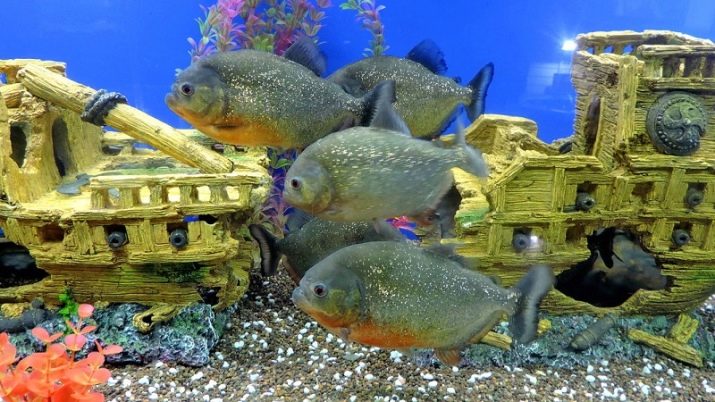
What and how to feed?
Feeding piranhas is a responsible task. Giving them food is worth it once a day. And the portion should be such that the fish ate it in just a few minutes. So they certainly will not overeat, and the water will remain clean, without food debris. The feed should not be too chopped, otherwise they will simply ignore it.
Piranhas can eat a variety of foods. So, predators need to give small fish, shrimp or squid, frogs or mice, as well as offal. In addition, you need to ensure that they are not hungry, otherwise they simply start to eat each other. However, once a week, you can do it unloading day.
For those fish that eat only vegetation, the following products can be added to the diet:
- Fresh zucchini or squash
- lettuce leaves;
- fresh young nettles;
- green cucumbers;
- celery or spinach;
- various plants for the aquarium.
In addition, you can give them bloodworms, but its amount should not exceed 20% of the total daily diet.
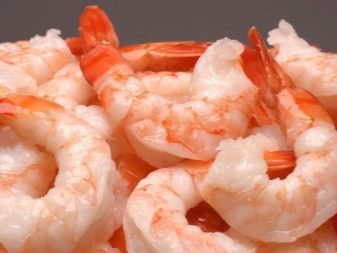

Breeding
To breed such little monsters at home, you need to make a lot of effort. First of all, for fish during spawning, the volume of the aquarium should be no less than 250 liters. In addition, during this period it is especially important to ensure that the water is always clean. Feed should contain a lot of protein.
Piranhas become puberty only when they turn 18 months old. However, determining their gender will be difficult. They look after fry pretty well.They pre-select a suitable place for laying eggs, and after it zealously guard. At one time, the female can throw up to 1,500 eggs. Incubation can last from two days to two weeks. During this period, the male can injure the female, which means that she must be put for a while in a separate container.
Small piranhas grow differently, so you need to sort them by size so that they do not hurt each other. To begin with, you can feed the fry with special feeds and only a little later transfer them to regular feed.
You can keep piranhas at home, but this will require familiarization with some rules for caring for them. Otherwise, they simply die.

On how to properly maintain aquarium piranhas, see the next video.
